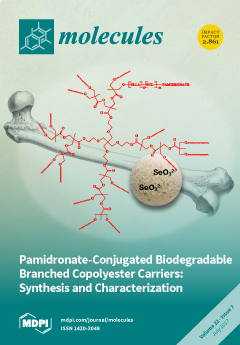A phytochemical study on the aerial parts of
Mikania micrantha led to the isolation of two new phenolic compounds, benzyl 5-
O-β-
d-glucopyranosyl-2,5-dihydroxybenzoate (
1) and (7
S,8
R)-
threo-dihydroxydehydrodiconiferyl alcohol 9-acetate (
2), together with
[...] Read more.
A phytochemical study on the aerial parts of
Mikania micrantha led to the isolation of two new phenolic compounds, benzyl 5-
O-β-
d-glucopyranosyl-2,5-dihydroxybenzoate (
1) and (7
S,8
R)-
threo-dihydroxydehydrodiconiferyl alcohol 9-acetate (
2), together with twelve known compounds, benzyl 2-
O-β-
d-glucopyranosyl-2,6-dihydroxybenzoate (
3), 4-allyl-2,6-dimethoxyphenol glucoside (
4), (+)-isolariciresinol (
5), icariol A
2 (
6), 9,10-dihydroxythymol (
7), 8,9,10-trihydroxythymol (
8), caffeic acid (
9),
p-coumaric acid (
10), ethyl protocatechuate (
11), procatechuic aldehyde (
12), 4-hydroxybenzoic acid (
13), and hydroquinone (
14). Their structures were elucidated on the basis of extensive spectroscopic analysis. Except
8 and
9, all the other compounds were isolated from this plant species for the first time. The antioxidant activity of those isolated compounds were evaluated using three different assays. Compounds
1,
2,
3,
9,
10,
13, and
14 demonstrated significant 2,2′-azinobis-(3-ethylbenzthiazoline-6-sulphonic acid) (ABTS) free radical cation scavenging activity ranging from SC
50 0.31 to 4.86 µM, which were more potent than
l-ascorbic acid (SC
50 = 10.48 µM). Compounds
5,
9,
11, and
12 exhibited more potent 1,1-diphenyl-2-picrylhydrazyl (DPPH) radical scavenging activity (SC
50 = 16.24–21.67 µM) than
l-ascorbic acid (39.48 µM). Moreover, the ferric reducing antioxidant power (FRAP) of compounds
2,
5,
9, and
11 were discovered to be also comparable to or even more potent than
l-ascorbic acid.
Full article






